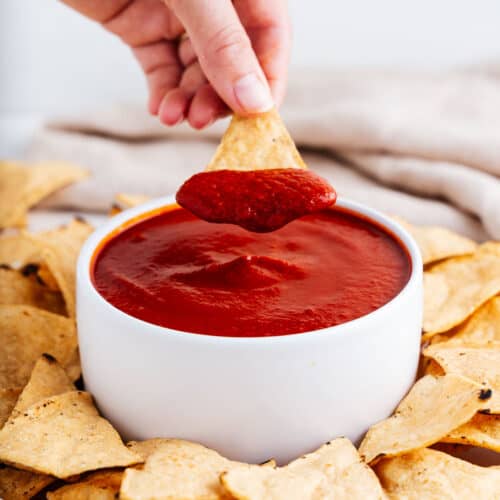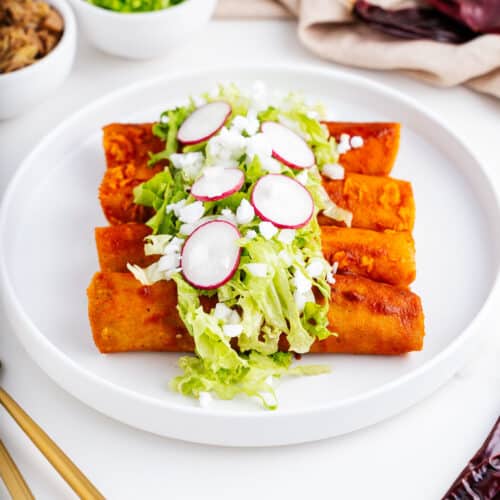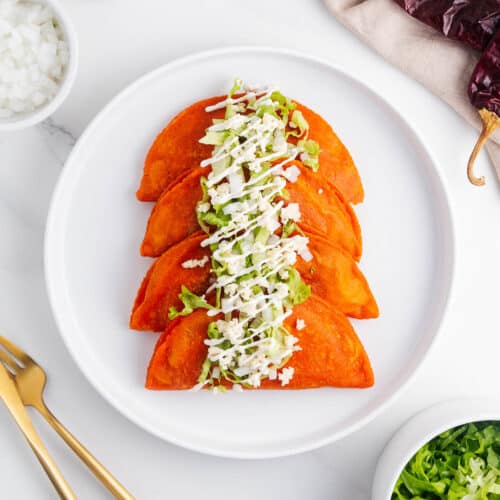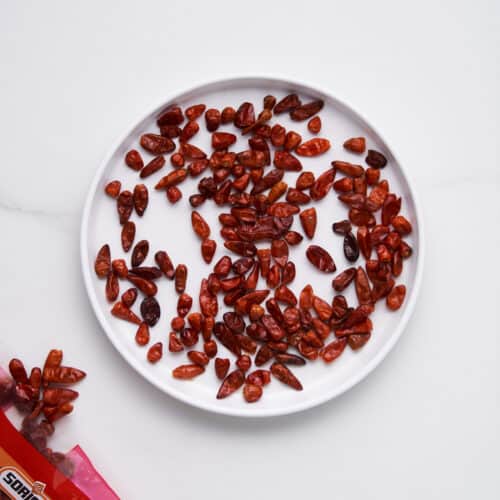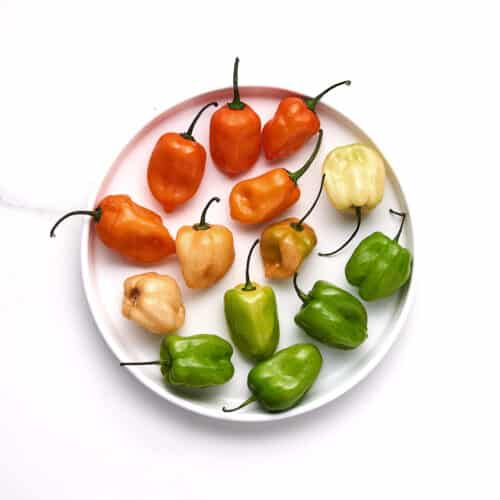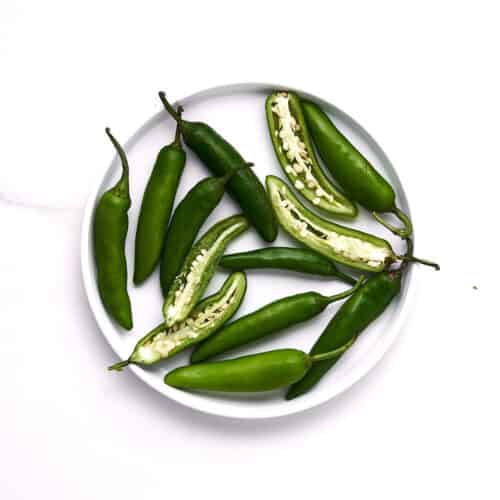Guajillo Peppers
Guajillo peppers are one of the most well-known and utilized chiles in Mexican cuisine. Find out everything you need to know in this detailed guide, including taste profile, rehydration techniques, and how to cook with them.

What are guajillo peppers?
Chiles guajillos (gwah-hee-ohs) are the dried form of mirasol chiles and one of the most common peppers in Mexico behind anchos. The mirasol group is made up of a few varieties, including guajillo, cascabel, and puya chiles.
Mirasol, which means “looking at the sun,” is in reference to how these peppers grow pointing up to the sky. Guajillo peppers are native to Mexico, mainly in the central and northern regions.
They stand out with their bright red hue and smooth, shiny skin. Typically, they grow long and slender, measuring about 4 to 6 inches in length and about an inch in width.
Varieties
The three mirasol chiles (chile puya, chile guajillo, and chile cascabel) are similar, but here are the key differences.
- Chile cascabel: The closest in flavor and spice to guajillo peppers, but slightly fruitier. Cascabel chiles look like little bells, and you can hear the seeds rattle if you shake them.
- Chile guajillo puya: Smaller and spicier than the larger guajillos — registering at 5,000-8,000 Scoville Heat Units.
- Chile guajillo: The largest variety of the three, providing the richest flavors.

Flavor profile
The flavor profile of guajillo peppers is quite unique from other chiles. They are characterized by a fruity sweetness with hints of berries and a subtle smoky undertone, which adds depth and richness to dishes without overpowering them.
This smokiness is not as intense as that found in chipotle meco peppers but is a more gentle, aromatic smokiness that complements their fruity characteristics. Their vibrant taste and color make guajillo peppers a staple ingredient in Mexican cooking.
Spice level
In terms of spiciness, guajillo peppers are relatively mild. They fall within the range of 2,500 to 5,000 on the Scoville Heat Scale, making them more approachable for those who prefer moderate heat in their dishes.
While not as hot as jalapeno peppers, they are spicier than poblano peppers. Their relatively mild heat also makes them a great counterpart to spicier varieties.

Health benefits
Like most chiles, guajillo peppers can offer a range of health benefits. They’re a great source of vitamins A and C, both of which are potent antioxidants needed for maintaining healthy eyes, skin, and immune function.
They also contain a special compound called capsaicin, which causes certain peppers to be spicy. This compound also contains anti-inflammatory, metabolism-boosting, and pain-relieving properties.
Cooking with guajillo peppers
Guajillo peppers are versatile and can be used in various culinary applications. They’re great for grinding into powders, rehydrating or steeping whole for sauces, or frying for broths and stews.
Contrary to popular belief, the chile guajillo variety is mainly added to recipes for its unique flavor profile rather than its spice level. Their mild nature makes them a great starting point for those looking to explore spicy peppers without too much heat.
Learn how to seed and rehydrate guajillo peppers in my video tutorial below!
Recipes
Being such a versatile chile, guajillos are included in all sorts of recipes. Here are some of my favorite dishes:
Storage
Your dried chiles should be kept in a cool, dry, and dark area (cupboards are always a good choice). Moisture can lead to mold growth and spoilage, so make sure they’re completely dry before storing them.
To keep the flavors fresh and the bugs out, keep them in an airtight container or bag. If you have to store them out in the open, use an opaque container to prevent light from degrading your chiles.
Buying guide
If you’re interested in Mexican cuisine, you’re definitely going to want to keep your pantry stocked with guajillos.
Look for guajillo peppers that are intact, pliable, and shiny with a deep red hue. Try to avoid broken and brittle ones, as this can indicate a diminished flavor. Also, steer clear of packages with a lot of dust and holes in the chiles from insect damage.
The best place to find guajillo peppers is at a Mexican food grocer if you live near one. If you don’t, you can order guajillo chiles on Amazon or other online marketplaces.

Substitutions
Although not quite the same, there are a few chiles that share similar characteristics with guajillo chiles. Top choices for substitutions include:
- New Mexico: With notes of sweet dried cherries and mild heat, New Mexico chiles make a suitable guajillo pepper replacement if you pair them with a spicier pepper like chile de árbol.
- California: While milder than guajillos, California chiles (dried Anaheims) are within the same flavor family and make a great substitution.
- Cascabel and pasilla (mixed): Cascabel chiles are earthy, nutty, and a little smoky, while pasilla chiles carry sweet, dried fruit notes. The flavor won’t be the exact same, but this combination makes a good replacement.
If you aren’t able to find those substitutes, ancho chiles work. They are also likely the easiest variety to find outside of Mexico.
Frequently asked questions
No, guajillo chiles are not smoked. If you’re looking for a chile with a smoky flavor, morita chiles are a better choice.
If you can find and grow mirasol chiles, then yes! Depending on the climate you live in, you can either sun-dry the chiles or use a dehydrator.
You may have toasted them too long, causing them to burn and turn the flavor bitter. Also, some people find the rehydrating liquid to be bitter. If a recipe calls for the rehydrating liquid and you don’t like the taste, replace it with vegetable broth or water.
More Mexican chiles
If you’re interested in learning about more popular chiles used in Mexican cooking, check out these other guides:
Dried chiles
Fresh chiles
Watch how to make it
Hungry for more?
If you enjoyed this recipe, please consider leaving a star rating and a comment down below! Your feedback not only helps others discover our blog but also gives us valuable insights from your experience.
Don’t forget to subscribe to our newsletter for the latest recipes, and check out our shop for our top kitchen recommendations. Thank you for supporting BBV!
Recipe

How to Rehydrate Guajillo Peppers
Equipment
- Kitchen shears
- Cast-iron skillet or comal
- Saucepan
Instructions
- Using kitchen shears, cut off the stems of the chiles and cut them open. Remove the seeds and veins and discard.
- Heat a cast-iron skillet over medium, then dry toast them for ~30-60 seconds per side, or until fragrant.
- Bring a saucepan of water to boil, then turn the heat off, add the guajillos in, cover the pot, and let the chiles rehydrate for 10-15 minutes, or until they feel soft and pliable.
- Your chiles are now ready to be used in a wide variety of recipes, from guajillo salsa to pozole.
Notes
Nutrition
Note: I’ve updated this post to include new information and helpful tips.
Justine Drosdovech is a food writer, photographer, and one of the founders of Broke Bank Vegan. She is a self-taught plant-based chef but uses her healthcare background to craft dishes that are both delicious and nourishing.


